Yiwei Yang
Towards Zero-Shot Annotation of the Built Environment with Vision-Language Models (Vision Paper)
Aug 01, 2024Abstract:Equitable urban transportation applications require high-fidelity digital representations of the built environment: not just streets and sidewalks, but bike lanes, marked and unmarked crossings, curb ramps and cuts, obstructions, traffic signals, signage, street markings, potholes, and more. Direct inspections and manual annotations are prohibitively expensive at scale. Conventional machine learning methods require substantial annotated training data for adequate performance. In this paper, we consider vision language models as a mechanism for annotating diverse urban features from satellite images, reducing the dependence on human annotation to produce large training sets. While these models have achieved impressive results in describing common objects in images captured from a human perspective, their training sets are less likely to include strong signals for esoteric features in the built environment, and their performance in these settings is therefore unclear. We demonstrate proof-of-concept combining a state-of-the-art vision language model and variants of a prompting strategy that asks the model to consider segmented elements independently of the original image. Experiments on two urban features -- stop lines and raised tables -- show that while direct zero-shot prompting correctly annotates nearly zero images, the pre-segmentation strategies can annotate images with near 40% intersection-over-union accuracy. We describe how these results inform a new research agenda in automatic annotation of the built environment to improve equity, accessibility, and safety at broad scale and in diverse environments.
DiffStega: Towards Universal Training-Free Coverless Image Steganography with Diffusion Models
Jul 15, 2024



Abstract:Traditional image steganography focuses on concealing one image within another, aiming to avoid steganalysis by unauthorized entities. Coverless image steganography (CIS) enhances imperceptibility by not using any cover image. Recent works have utilized text prompts as keys in CIS through diffusion models. However, this approach faces three challenges: invalidated when private prompt is guessed, crafting public prompts for semantic diversity, and the risk of prompt leakage during frequent transmission. To address these issues, we propose DiffStega, an innovative training-free diffusion-based CIS strategy for universal application. DiffStega uses a password-dependent reference image as an image prompt alongside the text, ensuring that only authorized parties can retrieve the hidden information. Furthermore, we develop Noise Flip technique to further secure the steganography against unauthorized decryption. To comprehensively assess our method across general CIS tasks, we create a dataset comprising various image steganography instances. Experiments indicate substantial improvements in our method over existing ones, particularly in aspects of versatility, password sensitivity, and recovery quality. Codes are available at \url{https://github.com/evtricks/DiffStega}.
Laboratory-Scale AI: Open-Weight Models are Competitive with ChatGPT Even in Low-Resource Settings
May 27, 2024



Abstract:The rapid proliferation of generative AI has raised questions about the competitiveness of lower-parameter, locally tunable, open-weight models relative to high-parameter, API-guarded, closed-weight models in terms of performance, domain adaptation, cost, and generalization. Centering under-resourced yet risk-intolerant settings in government, research, and healthcare, we see for-profit closed-weight models as incompatible with requirements for transparency, privacy, adaptability, and standards of evidence. Yet the performance penalty in using open-weight models, especially in low-data and low-resource settings, is unclear. We assess the feasibility of using smaller, open-weight models to replace GPT-4-Turbo in zero-shot, few-shot, and fine-tuned regimes, assuming access to only a single, low-cost GPU. We assess value-sensitive issues around bias, privacy, and abstention on three additional tasks relevant to those topics. We find that with relatively low effort, very low absolute monetary cost, and relatively little data for fine-tuning, small open-weight models can achieve competitive performance in domain-adapted tasks without sacrificing generality. We then run experiments considering practical issues in bias, privacy, and hallucination risk, finding that open models offer several benefits over closed models. We intend this work as a case study in understanding the opportunity cost of reproducibility and transparency over for-profit state-of-the-art zero shot performance, finding this cost to be marginal under realistic settings.
KEN: Kernel Extensions using Natural Language
Dec 09, 2023Abstract:The ability to modify and extend an operating system is an important feature for improving a system's security, reliability, and performance. The extended Berkeley Packet Filters (eBPF) ecosystem has emerged as the standard mechanism for extending the Linux kernel and has recently been ported to Windows. eBPF programs inject new logic into the kernel that the system will execute before or after existing logic. While the eBPF ecosystem provides a flexible mechanism for kernel extension, it is difficult for developers to write eBPF programs today. An eBPF developer must have deep knowledge of the internals of the operating system to determine where to place logic and cope with programming limitations on the control flow and data accesses of their eBPF program enforced by the eBPF verifier. This paper presents KEN, an alternative framework that alleviates the difficulty of writing an eBPF program by allowing Kernel Extensions to be written in Natural language. KEN uses recent advances in large language models (LLMs) to synthesize an eBPF program given a user's English language prompt. To ensure that LLM's output is semantically equivalent to the user's prompt, KEN employs a combination of LLM-empowered program comprehension, symbolic execution, and a series of feedback loops. KEN's key novelty is the combination of these techniques. In particular, the system uses symbolic execution in a novel structure that allows it to combine the results of program synthesis and program comprehension and build on the recent success that LLMs have shown for each of these tasks individually. To evaluate KEN, we developed a new corpus of natural language prompts for eBPF programs. We show that KEN produces correct eBPF programs on 80% which is an improvement of a factor of 2.67 compared to an LLM-empowered program synthesis baseline.
Contrastive Language-Vision AI Models Pretrained on Web-Scraped Multimodal Data Exhibit Sexual Objectification Bias
Dec 21, 2022Abstract:Nine language-vision AI models trained on web scrapes with the Contrastive Language-Image Pretraining (CLIP) objective are evaluated for evidence of a bias studied by psychologists: the sexual objectification of girls and women, which occurs when a person's human characteristics are disregarded and the person is treated as a body or a collection of body parts. A first experiment uses standardized images of women from the Sexual OBjectification and EMotion Database, and finds that, commensurate with prior research in psychology, human characteristics are disassociated from images of objectified women: the model's recognition of emotional state is mediated by whether the subject is fully or partially clothed. Embedding association tests (EATs) return significant effect sizes for both anger (d >.8) and sadness (d >.5). A second experiment measures the effect in a representative application: an automatic image captioner (Antarctic Captions) includes words denoting emotion less than 50% as often for images of partially clothed women than for images of fully clothed women. A third experiment finds that images of female professionals (scientists, doctors, executives) are likely to be associated with sexual descriptions relative to images of male professionals. A fourth experiment shows that a prompt of "a [age] year old girl" generates sexualized images (as determined by an NSFW classifier) up to 73% of the time for VQGAN-CLIP (age 17), and up to 40% of the time for Stable Diffusion (ages 14 and 18); the corresponding rate for boys never surpasses 9%. The evidence indicates that language-vision AI models trained on automatically collected web scrapes learn biases of sexual objectification, which propagate to downstream applications.
FocusNetv2: Imbalanced Large and Small Organ Segmentation with Adversarial Shape Constraint for Head and Neck CT Images
Apr 05, 2021



Abstract:Radiotherapy is a treatment where radiation is used to eliminate cancer cells. The delineation of organs-at-risk (OARs) is a vital step in radiotherapy treatment planning to avoid damage to healthy organs. For nasopharyngeal cancer, more than 20 OARs are needed to be precisely segmented in advance. The challenge of this task lies in complex anatomical structure, low-contrast organ contours, and the extremely imbalanced size between large and small organs. Common segmentation methods that treat them equally would generally lead to inaccurate small-organ labeling. We propose a novel two-stage deep neural network, FocusNetv2, to solve this challenging problem by automatically locating, ROI-pooling, and segmenting small organs with specifically designed small-organ localization and segmentation sub-networks while maintaining the accuracy of large organ segmentation. In addition to our original FocusNet, we employ a novel adversarial shape constraint on small organs to ensure the consistency between estimated small-organ shapes and organ shape prior knowledge. Our proposed framework is extensively tested on both self-collected dataset of 1,164 CT scans and the MICCAI Head and Neck Auto Segmentation Challenge 2015 dataset, which shows superior performance compared with state-of-the-art head and neck OAR segmentation methods.
Attack as Defense: Characterizing Adversarial Examples using Robustness
Mar 13, 2021

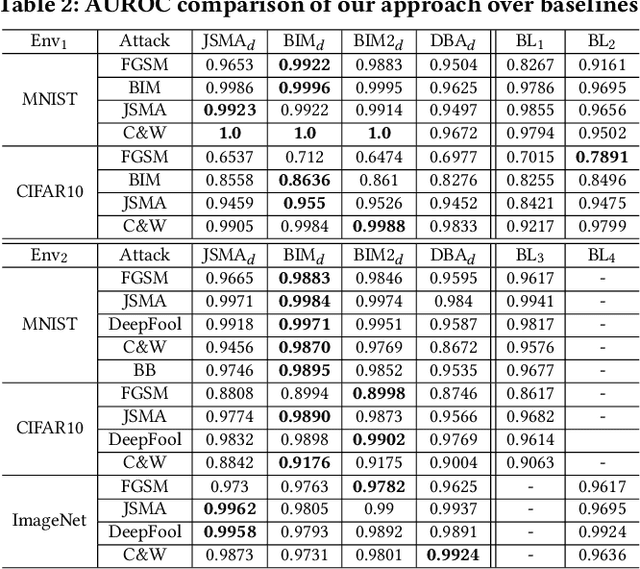

Abstract:As a new programming paradigm, deep learning has expanded its application to many real-world problems. At the same time, deep learning based software are found to be vulnerable to adversarial attacks. Though various defense mechanisms have been proposed to improve robustness of deep learning software, many of them are ineffective against adaptive attacks. In this work, we propose a novel characterization to distinguish adversarial examples from benign ones based on the observation that adversarial examples are significantly less robust than benign ones. As existing robustness measurement does not scale to large networks, we propose a novel defense framework, named attack as defense (A2D), to detect adversarial examples by effectively evaluating an example's robustness. A2D uses the cost of attacking an input for robustness evaluation and identifies those less robust examples as adversarial since less robust examples are easier to attack. Extensive experiment results on MNIST, CIFAR10 and ImageNet show that A2D is more effective than recent promising approaches. We also evaluate our defence against potential adaptive attacks and show that A2D is effective in defending carefully designed adaptive attacks, e.g., the attack success rate drops to 0% on CIFAR10.
A Saliency Dataset of Head and Eye Movements for Augmented Reality
Dec 12, 2019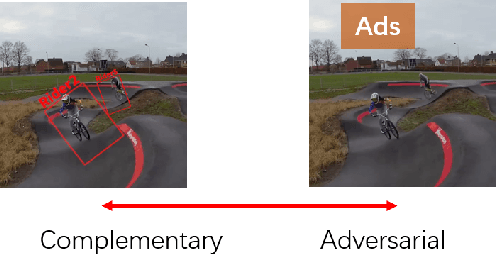
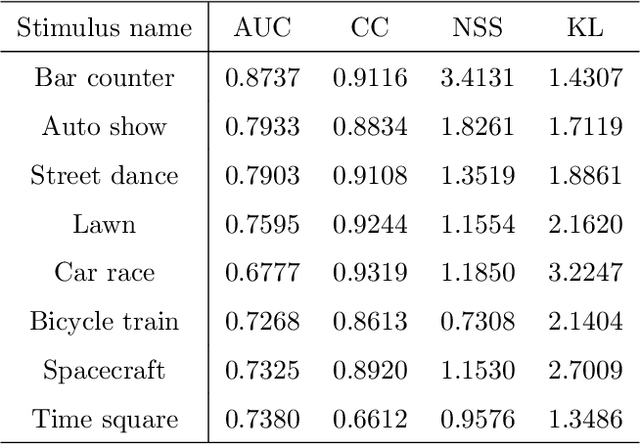
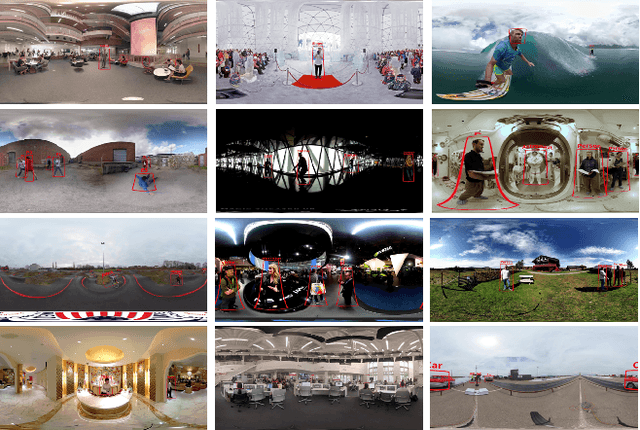
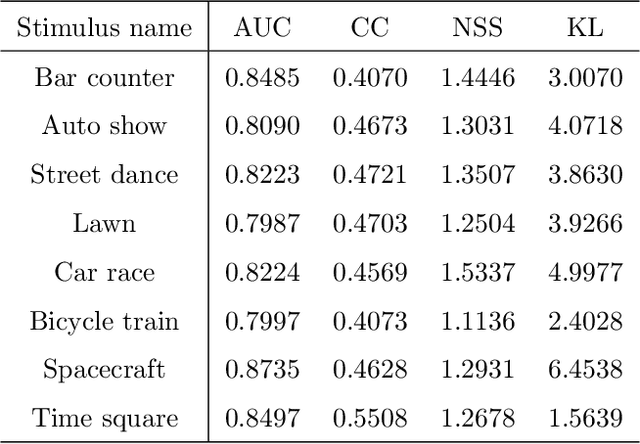
Abstract:In augmented reality (AR), correct and precise estimations of user's visual fixations and head movements can enhance the quality of experience by allocating more computation resources for the analysing, rendering and 3D registration on the areas of interest. However, there is no research about understanding the visual exploration of users when using an AR system or modeling AR visual attention. To bridge the gap between the real-world scene and the scene augmented by virtual information, we construct the ARVR saliency dataset with 100 diverse videos evaluated by 20 people. The virtual reality (VR) technique is employed to simulate the real-world, and annotations of object recognition and tracking as augmented contents are blended into the omnidirectional videos. Users can get the sense of experiencing AR when watching the augmented videos. The saliency annotations of head and eye movements for both original and augmented videos are collected which constitute the ARVR dataset.
FocusNet: Imbalanced Large and Small Organ Segmentation with an End-to-End Deep Neural Network for Head and Neck CT Images
Jul 28, 2019



Abstract:In this paper, we propose an end-to-end deep neural network for solving the problem of imbalanced large and small organ segmentation in head and neck (HaN) CT images. To conduct radiotherapy planning for nasopharyngeal cancer, more than 10 organs-at-risk (normal organs) need to be precisely segmented in advance. However, the size ratio between large and small organs in the head could reach hundreds. Directly using such imbalanced organ annotations to train deep neural networks generally leads to inaccurate small-organ label maps. We propose a novel end-to-end deep neural network to solve this challenging problem by automatically locating, ROI-pooling, and segmenting small organs with specifically designed small-organ sub-networks while maintaining the accuracy of large organ segmentation. A strong main network with densely connected atrous spatial pyramid pooling and squeeze-and-excitation modules is used for segmenting large organs, where large organs' label maps are directly output. For small organs, their probabilistic locations instead of label maps are estimated by the main network. High-resolution and multi-scale feature volumes for each small organ are ROI-pooled according to their locations and are fed into small-organ networks for accurate segmenting small organs. Our proposed network is extensively tested on both collected real data and the \emph{MICCAI Head and Neck Auto Segmentation Challenge 2015} dataset, and shows superior performance compared with state-of-the-art segmentation methods.
HEIDL: Learning Linguistic Expressions with Deep Learning and Human-in-the-Loop
Jul 25, 2019
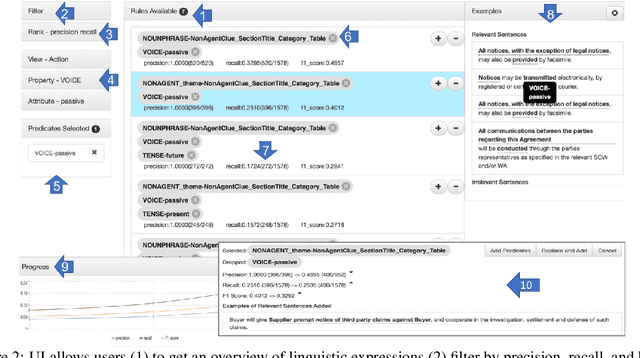
Abstract:While the role of humans is increasingly recognized in machine learning community, representation of and interaction with models in current human-in-the-loop machine learning (HITL-ML) approaches are too low-level and far-removed from human's conceptual models. We demonstrate HEIDL, a prototype HITL-ML system that exposes the machine-learned model through high-level, explainable linguistic expressions formed of predicates representing semantic structure of text. In HEIDL, human's role is elevated from simply evaluating model predictions to interpreting and even updating the model logic directly by enabling interaction with rule predicates themselves. Raising the currency of interaction to such semantic levels calls for new interaction paradigms between humans and machines that result in improved productivity for text analytics model development process. Moreover, by involving humans in the process, the human-machine co-created models generalize better to unseen data as domain experts are able to instill their expertise by extrapolating from what has been learned by automated algorithms from few labelled data.
 Add to Chrome
Add to Chrome Add to Firefox
Add to Firefox Add to Edge
Add to Edge